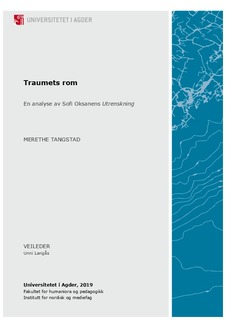| dc.description.abstract | This thesis is an analysis of Sofi Oksanen’s novel Utrenskning [Purge] (2011), with a particular focus on what significance the various rooms convey in the narrative of trauma. Utrenskning relates stories of occupation, violence and abuse through three generations of Estonian women, and how this has led totrauma, fear, and damaged relationships. The study’s primary theory is that the novel interprets aspects of traumatic experiences through a spatial point of view. One distinctive feature of Utrenskning is that almost all of the action plays out within different rooms. The rooms have different functions for the novel’s plot. The house in Estonia is the most important space, as significant portions of the action take place here. Within this house, the kitchen is the central space, as well as various closets. I have chosen to name another type of room a torture room. Here, we find the room in which Zara finds herself in Berlin, and the municipal building where Aliide, her sister, and her niece are tortured. In several of the novel’s houses, different objects are depicted which store something, for example food. I have called these the rooms of things. The various rooms and objects gain metaphorical meaning. They refer to spaces within the psyche and can be read as the novel’s aesthetic interpretation of memory processing within a traumatised individual. Utrenskning inaddition constructs what I term trauma’s relationroom. A structural room is displayed with the assistance of different tropes which are repeated and are contained within various clusters of motifs. Throughout the novel, their significance is widened in the sense that they shed light upon one another in a relationship of reflexive references. In this respect, the novel’s rooms function as a creative aesthetic practice, which contributes to how traumatic elements are expressed and interpreted, and notsimply reduced to being the scene of thematised traumas or a way to narrate which creates an immediate experience of what is traumatic. The theoretical contribution is derived from psychoanalytical and literary theoretical research into trauma with researchers such as Cathy Caruth, Bessel A. van der Kolk and Onno van der Hart, Mieke Bal, Unni Langås, Bjarne Markussen and Frederik Tygstrup as the primary sources. The theoretical chapters have two areas of focus. The first is upon the trauma phenomenon itself, whilst the second investigates questions related to the aesthetics of novels in connection with time and room, which is actualised in the study of how Utrenskning relates traumatic experiences. | nb_NO |

